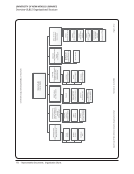28 · Survey Results: Survey Questions and Responses
We are just beginning to develop policies in this area.
We have no formal policies with regards to OSS. We are pragmatic in our approach to open source software, and
compare with vended solutions based on criteria noted earlier in this survey.
We know from experience there is a process, but could not locate the policies.
Whether a commercial vendor or OSS product best meets a given need is determined on a case-by-base basis.
10. Does your institution have either a sustainability or exit strategy related to OSS projects? N=71
Strategy Yes No
Sustainability strategy 21 50
Exit strategy 18 53
If there is either a sustainability or an exit strategy, and a document that describes the strategy,
please include the document in the Call for Documents at the end of the survey.
If there is a strategy, but no document, please briefly describe the strategy below.
Sustainability Strategy N=15
Informal. Must be sustainable. Implementing department is accountable.
Minimize customization.
Platform review on a regular basis (~five year cycle).
Provide staff support for ongoing development of our open source content management system (Drupal) and ongoing
support and development of our institutional repository (if we stay with an open source product after our pilot project).
Staff to support minimum customization data management a requirement.
Stated in strategic plan and through staffing, but no formal document.
Supported as a strategic application, that is, assigned as primary responsibility for a group or person in IT.
The closest is the Hydra partner agreement https://wiki.duraspace.org/display/hydra/Hydra+Community+Framework
The Kuali OLE project, not yet in production, is developing a sustainability plan to grow and sustain the software for
at least a decade. This includes ongoing support, in cash and in-kind, from partners, attracting new partners, and
partnering with commercial affiliates for software support, training, implementation, and development contributions.
The way in which we contribute and leverage OSS assures that the university has access to all OSS and can continue
to maintain, develop, or discard that technology according to our needs and priorities. We are involved in the strategic
steering, operational and development of the majority of OSS that we use.
We adopt only OSS projects that have a healthy, active community for collaboration/support. We also choose projects
with methods for contributing code back, and with good documentation so in-house work can begin quickly.
We avoid making extreme customizations that are super specific or require extensive changes to the base code, hence
sustaining our OSS from one version to another is relatively flexible.
We are just beginning to develop policies in this area.
We have no formal policies with regards to OSS. We are pragmatic in our approach to open source software, and
compare with vended solutions based on criteria noted earlier in this survey.
We know from experience there is a process, but could not locate the policies.
Whether a commercial vendor or OSS product best meets a given need is determined on a case-by-base basis.
10. Does your institution have either a sustainability or exit strategy related to OSS projects? N=71
Strategy Yes No
Sustainability strategy 21 50
Exit strategy 18 53
If there is either a sustainability or an exit strategy, and a document that describes the strategy,
please include the document in the Call for Documents at the end of the survey.
If there is a strategy, but no document, please briefly describe the strategy below.
Sustainability Strategy N=15
Informal. Must be sustainable. Implementing department is accountable.
Minimize customization.
Platform review on a regular basis (~five year cycle).
Provide staff support for ongoing development of our open source content management system (Drupal) and ongoing
support and development of our institutional repository (if we stay with an open source product after our pilot project).
Staff to support minimum customization data management a requirement.
Stated in strategic plan and through staffing, but no formal document.
Supported as a strategic application, that is, assigned as primary responsibility for a group or person in IT.
The closest is the Hydra partner agreement https://wiki.duraspace.org/display/hydra/Hydra+Community+Framework
The Kuali OLE project, not yet in production, is developing a sustainability plan to grow and sustain the software for
at least a decade. This includes ongoing support, in cash and in-kind, from partners, attracting new partners, and
partnering with commercial affiliates for software support, training, implementation, and development contributions.
The way in which we contribute and leverage OSS assures that the university has access to all OSS and can continue
to maintain, develop, or discard that technology according to our needs and priorities. We are involved in the strategic
steering, operational and development of the majority of OSS that we use.
We adopt only OSS projects that have a healthy, active community for collaboration/support. We also choose projects
with methods for contributing code back, and with good documentation so in-house work can begin quickly.
We avoid making extreme customizations that are super specific or require extensive changes to the base code, hence
sustaining our OSS from one version to another is relatively flexible.
























































































































































































